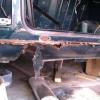Hi
I'm currently working on installing an R1 engine into my mini (see signature for link) and I would like to be able to use a Smiths centre speedo in addition to the R1 clocks that I'll be mounting behind the steering wheel. The problem is that the Smiths is mechanically driven where as the R1 clocks are digitally driven by a pulse from a speed sensor.
I have conducted some research and the best solution I can find is building a circuit to convert the square wave Yamaha pulse to PWM (Pulse Width Modulation) to drive a small DC motor which in turn will drive the mechanical speedo either directly mounted or via a cable. From what I've read this can be achieved using a PIC microcontroller of some sort to count the pulses and convert via a table to the appropriate PWM output.
My problem is that I understand a lot of the theory but I lack the ability to design a circuit and select appropriate components. I have found a few similar projects online but they either lack detailed explanations or are not quite what I require i.e. have a digital output on segment displays rather than DC motor.
Can anyone help with this? I'm hoping this isn't a huge task for someone with the right knowledge and motivation. I am capable of PCB assembly and I would even have a go at PIC programming if required but could really do with some help.
I know Abbott Tach sell what I require but is costs $350 dollars which just isn't worth it imo. http://www.abbott-ta...om/Cable X.html
Thanks
Luke
Edited by LukeH, 14 October 2015 - 08:25 AM.

















